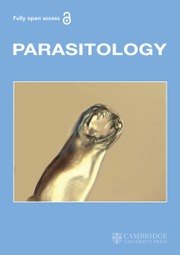Article contents
Anti-α-Gal antibodies detected by novel neoglycoproteins as a diagnostic tool for Old World cutaneous leishmaniasis caused by Leishmania major
Published online by Cambridge University Press: 14 June 2018
Abstract
Outbreaks of Old World cutaneous leishmaniasis (CL) have significantly increased due to the conflicts in the Middle East, with most of the cases occurring in resource-limited areas such as refugee settlements. The standard methods of diagnosis include microscopy and parasite culture, which have several limitations. To address the growing need for a CL diagnostic that can be field applicable, we have identified five candidate neoglycoproteins (NGPs): Galα (NGP3B), Galα(1,3)Galα (NGP17B), Galα(1,3)Galβ (NGP9B), Galα(1,6)[Galα(1,2)]Galβ (NGP11B), and Galα(1,3)Galβ(1,4)Glcβ (NGP1B) that are differentially recognized in sera from individuals with Leishmania major infection as compared with sera from heterologous controls. These candidates contain terminal, non-reducing α-galactopyranosyl (α-Gal) residues, which are known potent immunogens to humans. Logistic regression models found that NGP3B retained the best diagnostic potential (area under the curve from receiver-operating characteristic curve = 0.8). Our data add to the growing body of work demonstrating the exploitability of the human anti-α-Gal response in CL diagnosis.
- Type
- Special Issue Research Article
- Information
- Copyright
- Copyright © Cambridge University Press 2018
References
- 8
- Cited by



